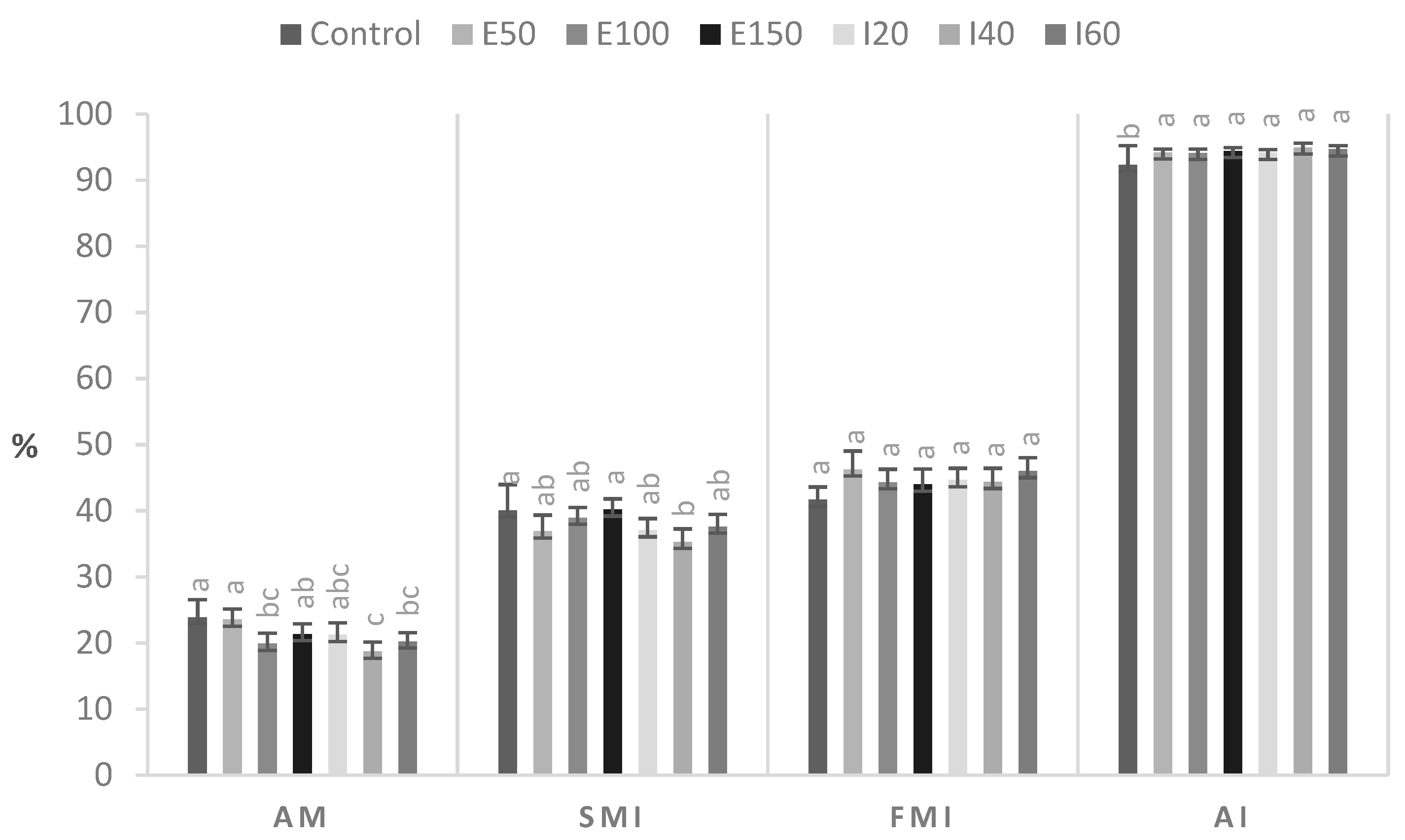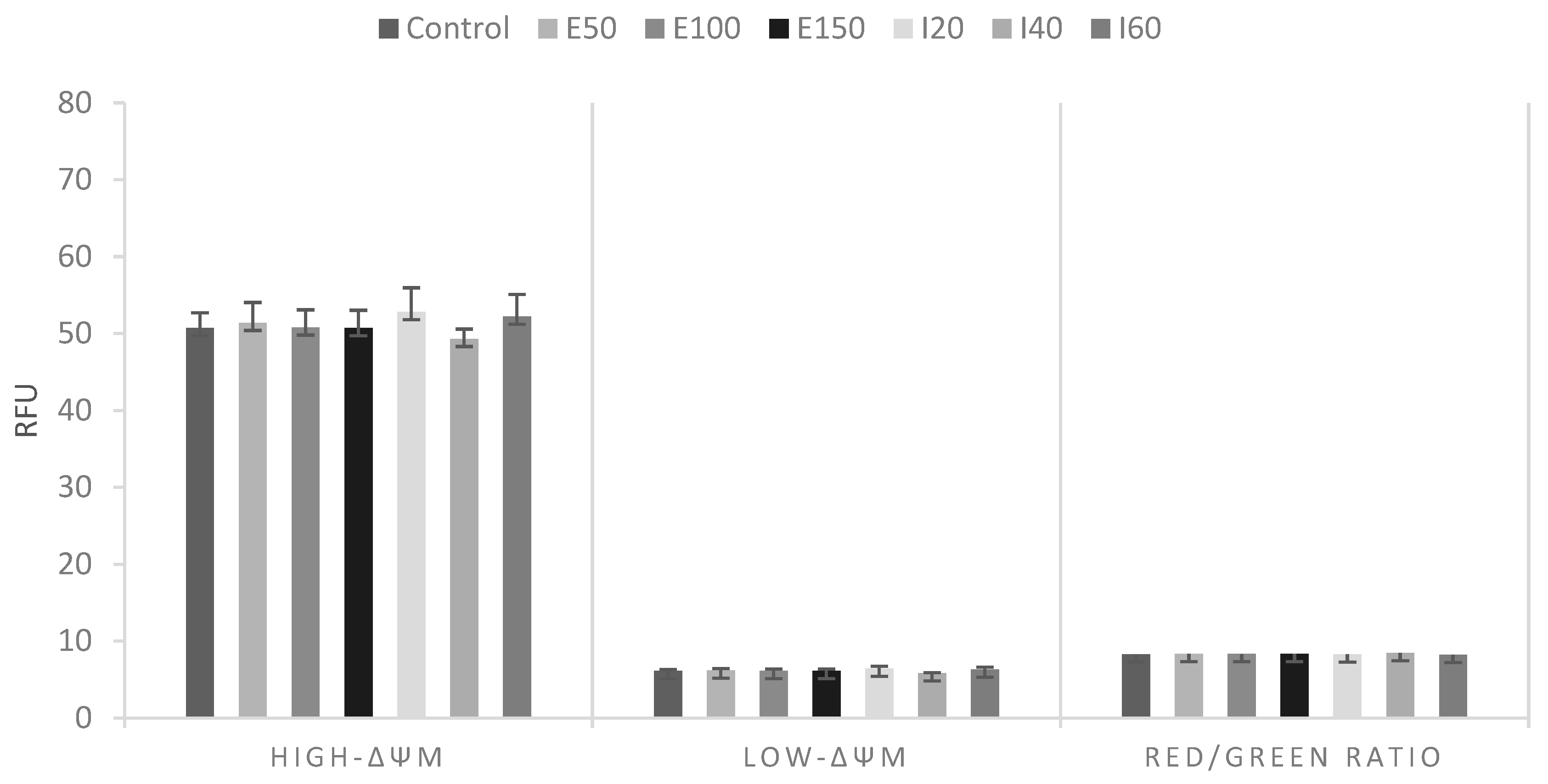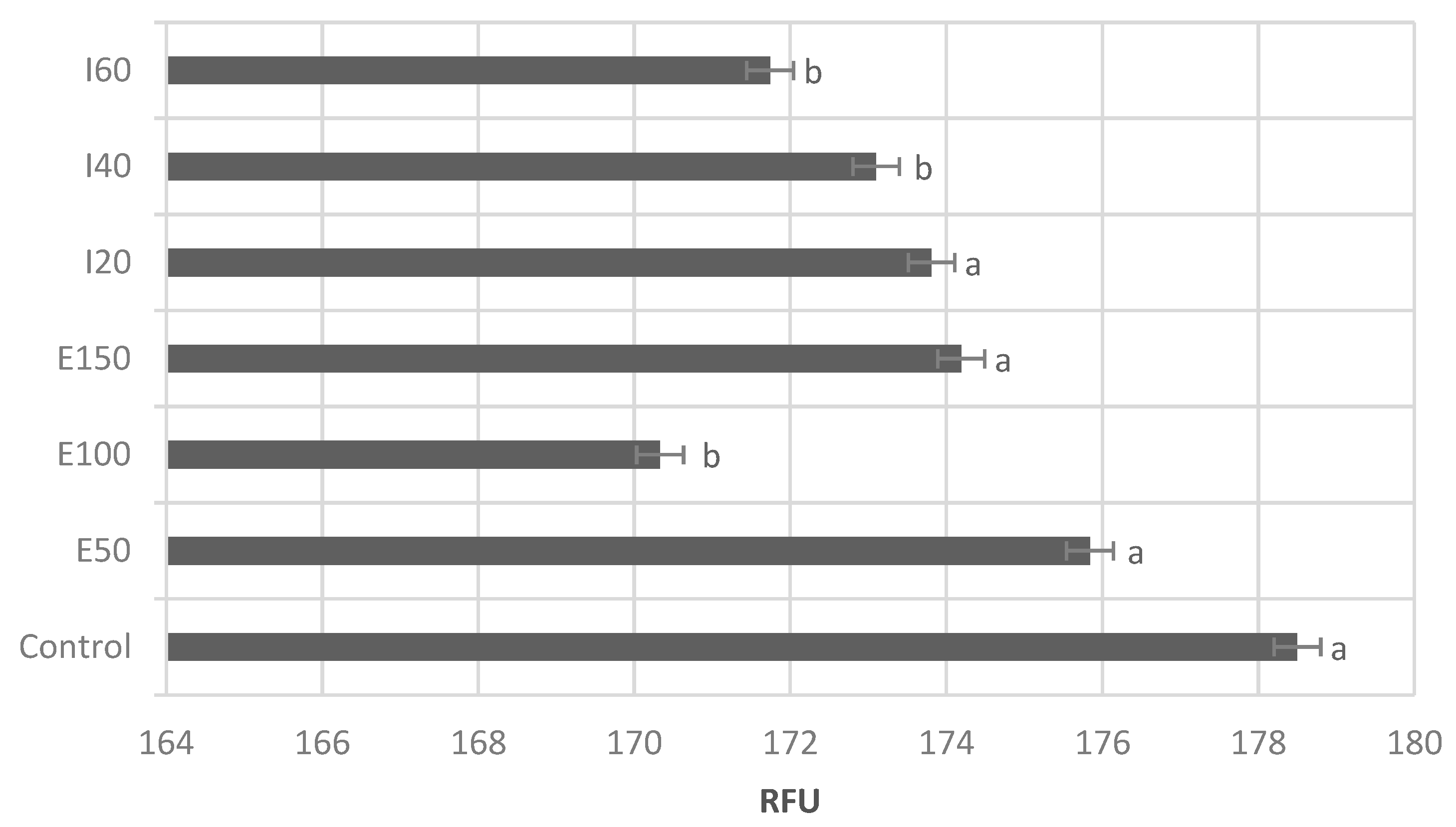Cryoprotective Effects of Ergothioneine and Isoespintanol on Canine Semen
Abstract
Simple Summary
Abstract
1. Introduction
2. Materials and Methods
2.1. Sample Collection
2.2. Evaluation of Raw Semen
2.3. Semen Freezing and Treatment Establishment
2.4. Post-Thaw Semen Quality Evaluation
2.4.1. Sperm Motility and Kinetics
2.4.2. Structural Membrane Integrity (SMI)
2.4.3. Abnormal Morphology (AM)
2.4.4. Functional Integrity of Membrane (FMI)
2.4.5. Acrosomal Membrane Integrity (AI)
2.4.6. Mitochondria Membrane Potential (ΔΨM)
2.4.7. Reactive Oxygen Species (ROS) Production
2.5. Statistical Analysis
3. Results
3.1. Raw Semen Quality
3.2. Quality of Thawed Semen
4. Discussion
5. Conclusions
Author Contributions
Funding
Institutional Review Board Statement
Informed Consent Statement
Data Availability Statement
Conflicts of Interest
References
- Sheikholeslami, S.A.; Soleimanzadeh, A.; Rakhshanpour, A.; Shirani, D. The evaluation of lycopene and cysteamine supplementation effects on sperm and oxidative stress parameters during chilled storage of canine semen. Reprod. Domest. Anim. 2020, 55, 1229–1239. [Google Scholar] [CrossRef]
- Cerdeira, J.; Sánchez-Calabuig, M.J.; Pérez-Gutiérrez, J.F.; Hijon, M.; Castaño, C.; Santiago-Moreno, J. Cryopreservation effects on canine sperm morphometric variables and ultrastructure: Comparison between vitrification and conventional freezing. Cryobiology 2020, 95, 164–170. [Google Scholar] [CrossRef]
- Strzezek, R.; Koziorowska-Gilun, M.; Kowalówka, M.; Strzezek, J. Characteristics of antioxidant system in dog semen. Pol. J. Vet. Sci. 2009, 12, 55–60. [Google Scholar] [PubMed]
- Ball, B.A.; Gravance, C.G.; Medina, V.; Baumber, J.; Liu, I.K.M. Catalase activity in equine semen. Am. J. Vet. Res. 2000, 61, 1026–1030. [Google Scholar] [CrossRef] [PubMed]
- Bencharif, D.; Dordas-Perpinya, M. Canine semen cryoconservation: Emerging data over the last 20 years. Reprod. Domest. Anim. 2020, 55, 61–65. [Google Scholar] [CrossRef]
- Lecewicz, M.; Strzeżek, R.; Kordan, W.; Majewska, A. Effect of extender supplementation with low-molecular-weight antioxidants on selected quality parameters of cryopreserved canine spermatozoa. J. Vet. Res. 2018, 62, 221–227. [Google Scholar] [CrossRef]
- Neagu, V.R.; García, B.M.; Sandoval, C.S.; Rodríguez, A.M.; Ferrusola, C.O.; Fernández, L.G.; Tapia, J.A.; Peña, F.J. Freezing dog semen in presence of the antioxidant butylated hydroxytoluene improves postthaw sperm membrane integrity. Theriogenology 2010, 73, 645–650. [Google Scholar] [CrossRef] [PubMed]
- Lucio, C.F.; Silva, L.C.G.; Regazzi, F.M.; Angrimani, D.S.R.; Nichi, M.; Assumpção, M.E.O.; Vannucchi, C.I. Effect of reduced glutathione (GSH) in canine sperm cryopreservation: In vitro and in vivo evaluation. Cryobiology 2016, 72, 135–140. [Google Scholar] [CrossRef] [PubMed]
- Carocho, M.; Ferreira, I.C.F.R. A review on antioxidants, prooxidants and related controversy: Natural and synthetic compounds, screening and analysis methodologies and future perspectives. Food Chem. Toxicol. 2013, 51, 15–25. [Google Scholar] [CrossRef]
- Michael, A.J.; Alexopoulos, C.; Pontiki, E.A.; Hadjipavlou-Litina, D.J.; Saratsis, P.; Ververidis, H.N.; Boscos, C.M. Quality and reactive oxygen species of extended canine semen after vitamin C supplementation. Theriogenology 2008, 70, 827–835. [Google Scholar] [CrossRef]
- Aparnak, P.; Saberivand, A. Effects of curcumin on canine semen parameters and expression of nox5 gene in cryopreserved spermatozoa. Vet. Res. Forum 2019, 10, 221–226. [Google Scholar] [CrossRef]
- Qamar, A.Y.; Fang, X.; Bang, S.; Kim, M.J.; Cho, J. Effects of kinetin supplementation on the post-thaw motility, viability, and structural integrity of dog sperm. Cryobiology 2020, 95, 90–96. [Google Scholar] [CrossRef]
- Kawasaki, Y.; Sakurai, D.; Yoshihara, T.; Tsuchida, M.; Harakawa, S.; Suzuki, H. Effect of quercetin on the motility of cryopreserved canine spermatozoa. Cryobiology 2020, 96, 50–54. [Google Scholar] [CrossRef] [PubMed]
- Thananurak, P.; Chuaychu-noo, N.; Thélie, A.; Phasuk, Y.; Vongpralub, T.; Blesbois, E. Different concentrations of cysteamine, ergothioneine, and serine modulate quality and fertilizing ability of cryopreserved chicken sperm. Poult. Sci. 2020, 99, 1185–1198. [Google Scholar] [CrossRef]
- Najafi, A.; Kia, H.D.; Mohammadi, H.; Najafi, M.H.; Zanganeh, Z.; Sharafi, M.; Martinez-Pastor, F.; Adeldust, H. Different concentrations of cysteamine and ergothioneine improve microscopic and oxidative parameters in ram semen frozen with a soybean lecithin extender. Cryobiology 2014, 69, 68–73. [Google Scholar] [CrossRef] [PubMed]
- Restrepo, G.; Rojano, B. Isoespintanol improves the post-thaw quality of stallion semen. Indian J. Anim. Sci. 2018, 88, 50–54. [Google Scholar]
- Borodina, I.; Kenny, L.C.; McCarthy, C.M.; Paramasivan, K.; Pretorius, E.; Roberts, T.J.; Van Der Hoek, S.A.; Kell, D.B. The biology of ergothioneine, an antioxidant nutraceutical. Nutr. Res. Rev. 2020, 33, 190–217. [Google Scholar] [CrossRef]
- Halliwell, B.; Cheah, I.K.; Tang, R.M.Y. Ergothioneine–a diet-derived antioxidant with therapeutic potential. FEBS Lett. 2018, 592, 3357–3366. [Google Scholar] [CrossRef]
- Rojano, B.; Saez, J.; Schinella, G.; Quijano, J.; Vélez, E.; Gil, A.; Notario, R. Experimental and theoretical determination of the antioxidant properties of isoespintanol (2-isopropyl-3,6-dimethoxy-5-methylphenol). J. Mol. Struct. 2008, 877, 1–6. [Google Scholar] [CrossRef]
- González Arbeláez, L.F.; Ciocci Pardo, A.; Fantinelli, J.C.; Rojano, B.; Schinella, G.R.; Mosca, S.M. Isoespintanol, a monoterpene isolated from oxandra cf xylopioides, ameliorates the myocardial ischemia-reperfusion injury by AKT/PKCε/eNOS-dependent pathways. Naunyn. Schmiedebergs. Arch. Pharmacol. 2020, 393, 629–638. [Google Scholar] [CrossRef] [PubMed]
- Sánchez-Calabuig, M.J.; Maillo, V.; Beltrán-Breña, P.; de la Fuente Martínez, J.; Galera-Carrillo, S.; Pérez-Gutiérrez, J.F.; Pérez-Cerezales, S. Cryopreservation of canine sperm using egg yolk and soy bean based extenders. Reprod. Biol. 2017, 17, 233–238. [Google Scholar] [CrossRef]
- Restrepo, G.B.; Rojano, B.A. Antioxidant activity of isoespintanol and thymol in cryopreserved stallion semen. Rev. Investig. Vet. Peru 2018, 29, 205–216. [Google Scholar] [CrossRef]
- Restrepo, G.; Carlos Andrés Madrid, R.; Laura Prieto, R.; Juan Esteban Duque, C.; Alexandra Usuga, S. Freezing of epididymal canine sperm with centrifuged egg yolk. Rev. Investig. Vet. Peru 2017, 28, 876–885. [Google Scholar] [CrossRef][Green Version]
- Gamboa, S.; Rodrigues, A.S.; Henriques, L.; Batista, C.; Ramalho-Santos, J. Seasonal functional relevance of sperm characteristics in equine spermatozoa. Theriogenology 2010, 73, 950–958. [Google Scholar] [CrossRef]
- Neild, D.; Chaves, G.; Flores, M.; Mora, N.; Beconi, M.; Agüero, A. Hypoosmotic test in equine spermatozoa. Theriogenology 1999, 51, 721–727. [Google Scholar] [CrossRef]
- Rathi, R.; Colenbrander, B.; Bevers, M.M.; Gadella, B.M. Evaluation of in vitro capacitation of stallion spermatozoa. Biol. Reprod. 2001, 65, 462–470. [Google Scholar] [CrossRef] [PubMed]
- Mortimer, D.; Curtis, E.F.; Miller, R.G. Specific labelling by peanut agglutinin of the outer acrosomal membrane of the human spermatozoon. J. Reprod. Fertil. 1987, 81, 127–135. [Google Scholar] [CrossRef]
- Rajabi-Toustani, R.; Akter, Q.S.; Almadaly, E.A.; Hoshino, Y.; Adachi, H.; Mukoujima, K.; Murase, T. Methodological improvement of fluorescein isothiocyanate peanut agglutinin (FITC-PNA) acrosomal integrity staining for frozenthawed Japanese Black bull spermatozoa. J. Vet. Med. Sci. 2019, 81, 694–702. [Google Scholar] [CrossRef] [PubMed]
- Gravance, C.G.; Garner, D.L.; Baumber, J.; Ball, B.A. Assessment of equine sperm mitochondrial function using JC-1. Theriogenology 2000, 53, 1691–1703. [Google Scholar] [CrossRef]
- Aitken, R.J.; Smith, T.B.; Lord, T.; Kuczera, L.; Koppers, A.J.; Naumovski, N.; Connaughton, H.; Baker, M.A.; De Iuliis, G.N. On methods for the detection of reactive oxygen species generation by human spermatozoa: Analysis of the cellular responses to catechol oestrogen, lipid aldehyde, menadione and arachidonic acid. Andrology 2013, 1, 192–205. [Google Scholar] [CrossRef] [PubMed]
- Rojano, B.; Gaviria, C.; Gil, M.; Saez, J.; Schinella, G.; Tournier, H. Actividad antioxidante del isoespintanol en diferentes medios. Vitae 2008, 15, 173–181. [Google Scholar]
- Lucio, C.F.; Regazzi, F.M.; Silva, L.C.G.; Angrimani, D.S.R.; Nichi, M.; Vannucchi, C.I. Oxidative stress at different stages of two-step semen cryopreservation procedures in dogs. Theriogenology 2016, 85, 1568–1575. [Google Scholar] [CrossRef]
- Farstad, W. Cryopreservation of canine semen—New challenges. Reprod. Domest. Anim. 2009, 44, 336–341. [Google Scholar] [CrossRef] [PubMed]
- Çoyan, K.; Başpinar, N.; Bucak, M.N.; Akalin, P.P. Effects of cysteine and ergothioneine on post-thawed Merino ram sperm and biochemical parameters. Cryobiology 2011, 63, 1–6. [Google Scholar] [CrossRef] [PubMed]
- Çoyan, K.; Bucak, M.N.; Başpinar, N.; Taşpinar, M.; Aydos, S. Ergothioneine attenuates the DNA damage of post-thawed Merino ram sperm. Small Rumin. Res. 2012, 106, 165–167. [Google Scholar] [CrossRef]
- Yildiz, S.; Öztürkler, Y.; Ari, U.Ç.; Lehimcioğlu, N.C.; Atakişi, E.; Kulaksiz, R. Koç spermasının dondurulması üzerine L-Ergothionin, N-Asetil sistein ve sisteinin etkileri. Kafkas Univ. Vet. Fak. Derg. 2015, 21, 81–86. [Google Scholar] [CrossRef]
- Franzoni, F.; Colognato, R.; Galetta, F.; Laurenza, I.; Barsotti, M.; Di Stefano, R.; Bocchetti, R.; Regoli, F.; Carpi, A.; Balbarini, A.; et al. An in vitro study on the free radical scavenging capacity of ergothioneine: Comparison with reduced glutathione, uric acid and trolox. Biomed. Pharmacother. 2006, 60, 453–457. [Google Scholar] [CrossRef] [PubMed]
- Grandhaye, J.; Partyka, A.; Ligocka, Z.; Dudek, A.; Niżański, W.; Jeanpierre, E.; Estienne, A.; Froment, P. Metformin Improves Quality of Post-Thaw Canine Semen. Animal 2020, 10, 287. [Google Scholar] [CrossRef]
- Rijsselaere, T.; Van Soom, A.; Van Cruchten, S.; Coryn, M.; Görtz, K.; Maes, D.; de Kruif, A. Sperm distribution in the genital tract of the bitch following artificial insemination in relation to the time of ovulation. Reproduction 2004, 128, 801–811. [Google Scholar] [CrossRef]
- Nöthling, J.O.; Shuttleworth, R.; De Haas, K.; Thompson, P.N. Homologous prostatic fluid added to frozen–thawed dog spermatozoa prior to intravaginal insemination of bitches resulted in better fertility than albumin-free TALP. Theriogenology 2005, 64, 975–991. [Google Scholar] [CrossRef]
- Thomassen, R.; Sanson, G.; Krogenæs, A.; Fougner, J.A.; Berg, K.A.; Farstad, W. Artificial insemination with frozen semen in dogs: A retrospective study of 10 years using a non-surgical approach. Theriogenology 2006, 66, 1645–1650. [Google Scholar] [CrossRef] [PubMed]



| Mean | SD | CV | SEM | Min | Max | |
|---|---|---|---|---|---|---|
| Volume (mL) | 1.48 | 0.66 | 44.67 | 0.18 | 0.8 | 3 |
| Sperm concentration (106/mL) | 237.54 | 107.96 | 45.45 | 29.94 | 51 | 463 |
| Motility (%) | 88.46 | 5.55 | 6.27 | 1.54 | 80 | 95 |
| Structural membrane integrity (%) | 92.31 | 4.57 | 4.95 | 1.27 | 81 | 97 |
| Abnormal morphology (%) | 18.08 | 7.57 | 41.85 | 2.10 | 7 | 33 |
| Functional membrane integrity (%) | 88.31 | 6.93 | 7.85 | 1.92 | 76 | 99 |
| Control | E50 | E100 | E150 | I20 | I40 | I60 | |
|---|---|---|---|---|---|---|---|
| TM | 49.61 ± 3.90 b | 56.61 ± 4.42 ab | 60.65 ± 3.56 a | 54.40 ± 3.63 ab | 54.77 ± 3.57 ab | 51.72 ± 3.48 b | 52.18 ± 4.02 b |
| PM | 20.17 ± 2.72 b | 24.73 ± 3.02 ab | 26.41 ± 2.37 a | 22.04 ± 2.59 ab | 20.17 ± 2.21 b | 21.41 ± 2.49 ab | 20.28 ± 2.84 b |
| RAP | 12.31 ± 1.91 b | 16.92 ± 2.24 ab | 17.67 ± 1.80 a | 14.24 ± 2.03 ab | 13.09 ± 1.79 b | 13.64 ± 1.87 ab | 13.60 ± 2.11 ab |
| VCL | 58.39 ± 2.88 ab | 60.23 ± 3.14 ab | 62.85 ± 2.22 a | 56.00 ± 2.74 b | 56.64 ± 2.68 b | 55.87 ± 2.75 b | 54.37 ± 3.14 b |
| VAP | 42.77 ± 2.59 abc | 45.50 ± 2.8 ab | 47.97 ± 2.08 a | 43.00 ± 2.38 abc | 41.45 ± 2.48 bc | 41.85 ± 2.23 bc | 39.26 ± 2.56 c |
| VSL | 35.97 ± 2.54 bc | 38.38 ± 2.88 ab | 41.35 ± 1.97 a | 37.27 ± 2.23 abc | 35.21 ± 2.41 bc | 35.77 ± 2.08 bc | 32.89 ± 2.41 c |
| ALH | 2.34 ± 0.09 a | 2.28 ± 0.11 a | 2.31 ± 0.07 a | 2.18 ± 0.08 a | 2.30 ± 0.09 a | 2.23 ± 0.08 a | 2.32 ± 0.12 a |
| BCF | 7.08 ± 0.40 ab | 7.36 ± 0.42 ab | 7.68 ± 0.28 a | 7.34 ± 0.29 ab | 6.96 ± 0.35 a | 7.01 ± 0.28 ab | 6.63 ± 0.39 b |
| HYP | 2.59 ± 1.12 a | 2.28 ± 0.84 ab | 2.57 ± 1.07 a | 1.08 ± 0.41 b | 1.87 ± 0.76 ab | 2.19 ± 0.74 ab | 1.42 ± 0.00 ab |
Publisher’s Note: MDPI stays neutral with regard to jurisdictional claims in published maps and institutional affiliations. |
© 2021 by the authors. Licensee MDPI, Basel, Switzerland. This article is an open access article distributed under the terms and conditions of the Creative Commons Attribution (CC BY) license (https://creativecommons.org/licenses/by/4.0/).
Share and Cite
Usuga, A.; Tejera, I.; Gómez, J.; Restrepo, O.; Rojano, B.; Restrepo, G. Cryoprotective Effects of Ergothioneine and Isoespintanol on Canine Semen. Animals 2021, 11, 2757. https://doi.org/10.3390/ani11102757
Usuga A, Tejera I, Gómez J, Restrepo O, Rojano B, Restrepo G. Cryoprotective Effects of Ergothioneine and Isoespintanol on Canine Semen. Animals. 2021; 11(10):2757. https://doi.org/10.3390/ani11102757
Chicago/Turabian StyleUsuga, Alexandra, Irene Tejera, Jorge Gómez, Oliver Restrepo, Benjamín Rojano, and Giovanni Restrepo. 2021. "Cryoprotective Effects of Ergothioneine and Isoespintanol on Canine Semen" Animals 11, no. 10: 2757. https://doi.org/10.3390/ani11102757
APA StyleUsuga, A., Tejera, I., Gómez, J., Restrepo, O., Rojano, B., & Restrepo, G. (2021). Cryoprotective Effects of Ergothioneine and Isoespintanol on Canine Semen. Animals, 11(10), 2757. https://doi.org/10.3390/ani11102757







